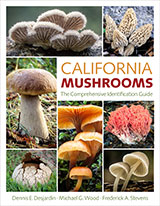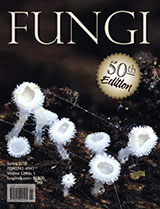Book Review
The Genus Tricholoma
Most mushroom hunters who have a keen interest in identifying all of the different mushrooms they find are familiar with the six-volume series, Fungi of Switzerland, generally known as the “Swiss books.” I don’t know whether the Swiss mycologists are big baseball fans or not, but they “batted 1000” by producing 6 out of 6 excellent books. More recently, the Danish Mycological Society embarked on a series of books covering the mushrooms of northern Europe. Although very different from the Swiss books in their approach, they are now 4 for 4, maintaining their own perfect batting average.
 This newest offering covers all 67 species of Tricholoma currently known to occur in northern Europe, west of Russia, Belarus, and Ukraine, and including the northern parts of the Carpathians, the Alps, and the northern half of France. Of the included taxa, about half have been reported from North America so the book is a useful supplement to our own publications such as Tricholomas of North America by Bessette et al., and Agaricales of California — Volume 11: Tricholoma by Kris Shanks. Not only that, but it provides another basis for comparing our fungi with those in Europe so that we can assess the correctness of our use of many European names for our tricholomas.
This newest offering covers all 67 species of Tricholoma currently known to occur in northern Europe, west of Russia, Belarus, and Ukraine, and including the northern parts of the Carpathians, the Alps, and the northern half of France. Of the included taxa, about half have been reported from North America so the book is a useful supplement to our own publications such as Tricholomas of North America by Bessette et al., and Agaricales of California — Volume 11: Tricholoma by Kris Shanks. Not only that, but it provides another basis for comparing our fungi with those in Europe so that we can assess the correctness of our use of many European names for our tricholomas.
With some modifications, the organization of this volume is much the same as that of its three predecessors (covering Hygrocybe, Lactarius, and Hebeloma). After the preface, an introduction summarizes the authors’ methodology, a taxonomic description of Tricholoma covering both the macroscopic and microscopic features, and their systematic arrangement of taxa within the genus. The classification reflects the results of recent studies, including molecular phylogenetics, but the authors are careful to point out that it is a work in progress. They present a phylogenetic tree based on preliminary analysis of ITS (Internal Transcribed Spacer region of the ribosomal RNA “gene”) data and make numerous references to a forthcoming journal article that will present the phylogenetic analysis in greater detail. They then discuss the ecology of tricholomas, including the typical habitats in which they are found, their distribution patterns, and conservation of the rarer species. This section concludes with a discussion of edibility and toxicity, as the genus includes species in both categories.
Next come keys—a main key followed by six others covering sub-groups based primarily on the presence/absence of a ring and the color of the cap surface. Macroscopic features and habitat are emphasized throughout, with measurement of spores or length of hyphae being needed in some cases. Following the keys is a series of lists of illustrations of tricholomas in 11 prominent European publications that the authors feel are, or might be, misidentified, and provide their best assessment as to the proper name. I like this feature and wish other authors were willing to include it in their works.
 The main section of the book contains the descriptions. Each species receives at least two pages that include a comprehensive but succinct description, comments on ecology and distribution, and a discussion of the taxon in relation to possible lookalikes and other taxonomists’ concepts. Amateur mycologists will appreciate that the authors use fairly broad species concepts. Illustrations for each taxon include very high quality color photographs that are particularly effective for identification, a distribution map, and drawings of spores.
The main section of the book contains the descriptions. Each species receives at least two pages that include a comprehensive but succinct description, comments on ecology and distribution, and a discussion of the taxon in relation to possible lookalikes and other taxonomists’ concepts. Amateur mycologists will appreciate that the authors use fairly broad species concepts. Illustrations for each taxon include very high quality color photographs that are particularly effective for identification, a distribution map, and drawings of spores.
The book concludes with presentations of a variety of useful information — sources of information used to compile the distribution maps, data on the material studied and illustrated, information about the type collections selected, a list of “common name” equivalents of Kornerup & Wanscher (“Methuen”) color codes, and a 7-page list of references—and a taxonomic index.
Kudos to Christensen, Heilmann-Clausen, and the editors of the Fungi of Northern Europe series on another first-class effort. Beautiful, professionally presented, and just the right amount of information to help us get a handle on Tricholoma species — ours, theirs, or otherwise.
— Review by Steve Trudell, Seattle, WA
— Originally published in Fungi


